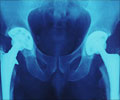Highlights
- Women who are obese or overweight based on their body mass index, abdominal obesity and body fat percentage are at a higher risk of rheumatoid arthritis (RA).
- Waist size //>88 cms was related to abdominal obesity and BMI>28 - 30kg/m2 were the criteria for assessment.
- However the risk between obesity, body fat and waist size holds unclear in men.
Lead author Dr. Asta Linauskas from University Hospital, Aarhus, Denmark said, "One possible explanation for these inconsistencies is that while BMI has been the preferred surrogate measure for being overweight in these studies, BMI only correlates modestly with total amount of body fat and does not accurately reflect fat distribution.”
Rheumatoid Arthritis
Rheumatoid arthritis is a chronic inflammatory disease of the joints and the surrounding tissues. It is an autoimmune disease. The exact cause of rheumatoid arthritis is unknown. Infection, genes and hormonal changes may be linked to the disease.
Rheumatoid arthritis can occur at any age, but is more common in middle age. Women are more prone to the disease than men. Rheumatoid arthritis leads to pain, swelling, stiffness and loss of function in the joints. Being a systemic disease, it tends to affect other organs in the body as well.
Though the exact cause of RA is unknown, hereditary, age between 30 - 50, people with Human Leukocyte Antigen (HLA) DR4 and gender are few of the risk factors associated with RA. Now, obesity, body fat and waist circumference also stand out as risk factors.
From a population of 54,284 subjects (52% female), aged between 50 and 64 years at the time of recruitment between 1993 and 1997, 283 women and 110 men developed RA during a median follow-up period of 21 years. The median time to onset of RA was 7 (interquartile range of 4-11) years.
Body fat composition measurements and data on lifestyle factors were collected at enrollment. The participants were followed until development of RA, death, loss to follow-up or October 2016, whichever came first.
Hazard ratios were adjusted for potential confounding from age, smoking status, total tobacco consumption (g/day), smoking duration, alcohol consumption (g/day), socio-economic status, physical activity (based on a formula that calculates the energy expenditure of different physical activities), and total intake of n-3 fatty acids.
Study Findings
"Our results support an association between the risk of developing RA and three different criteria for being overweight or obese in women. We believe RA should be included in the list of all the other medical conditions linked to obesity. It would certainly make sense for women with a family history of RA to try to avoid becoming overweight," said Linauskas.
- In women, the hazard ratio for a BMI of 25-29.99 kg/m2 (considered overweight) was 1.48 (95 % CI 1.14-1.91), and for a BMI >30 kg/m2 (considered obese) was 1.54 (1.09-2.17).
- For abdominal obesity, defined in women as a waist circumference >88 cm, the hazard ratio was 1.24 (0.96-1.61).
- For each 1% higher body fat percentage, in women the hazard ratio was 1.03 (1.01-1.05).
- In men, the hazard ratio for a BMI of 25-29.99 kg/m2 was 0.83 (0.55-1.24), and for a BMI >30 kg/m2 was 0.69 (0.37-1.30).
- For abdominal obesity, defined in men as a waist circumference >102 cm, the hazard ratio was 1.16 (0.75-1.80).
- For each 1% higher body fat percentage, in men the hazard ratio was 0.99 (0.96-1.03).
Reference
- Asta Linauskas et al.,Body fat and waist size linked to increased risk of developing rheumatoid arthritis in women, Annual European Congress of Rheumatology (EULAR) 2017.
Source-Medindia
















